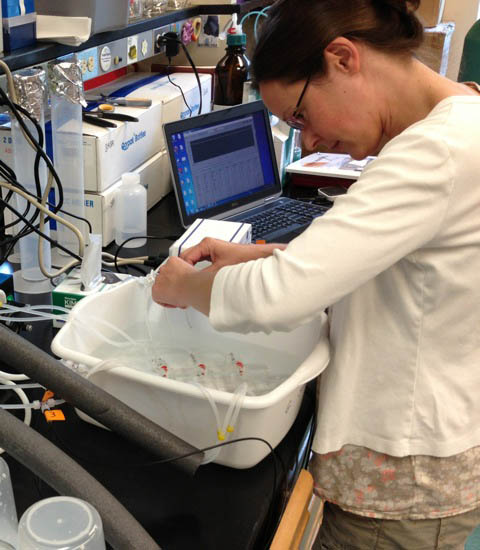Stressed outResearchers investigate ocean acidification effects on Antarctic krillPosted July 3, 2014
Krill are a favorite food of penguins and whales. Humans harvest the tiny, shrimplike crustaceans for omega-3-boosting supplements. Climate change around the Antarctic Peninsula is reducing sea ice extent and duration in certain regions, robbing the dominant species Euphausia superba of a key habitat. That would seem to be enough trouble for one of the Southern Ocean’s keystone species in the food web. But some scientists are wondering if Antarctic krill will face even more stress in the future, as the climate warms and changes. How will lower water pH and higher ocean temperatures affect their physiology and growth? A small team of marine biologists has a grant from the National Science Foundation’s Division of Polar Programs The researchers worked out of the U.S. Antarctic Program’s Palmer Station The current project is based on some preliminary work Grace Saba 
Photo Credit: Ryan Fantasia
Grace Saba tests respirometry equipment used to measure oxygen consumption in Antarctic krill.
Her studies on the krill – one of the main subjects of the two-decade-long-plus Palmer LTER program – found that under conditions of elevated carbon dioxide, which lowers the pH of ocean water, the animals had higher feeding rates and higher nutrient excretion rates. “I believe the krill had to work harder under these more stressful conditions which increased their need for food,” explained Saba, now an assistant research professor at Rutgers and principal investigator on the newly funded project to investigate krill stress in an acidifying, warmer ocean. The Intergovernmental Panel on Climate Change (IPCC) For the Southern Ocean, which circles the entire Antarctic continent, that could mean surface water temperatures may rise about 3 degrees Celsius and subsurface water pH might drop from about 8.1 to about 7.7, according to Saba. The pH level, measured in units, is a calculation of the balance of a liquid’s acidity and alkalinity. The lower a liquid’s pH number, the higher its acidity. As CO2 dissolves in the water, it lowers the pH, which shrinks the pool of carbonate ions in the ocean that marine organisms such as sea urchins and corals use to build skeletons and shells. While krill are not calcifying organisms, lower ocean pH could affect their physiology in other ways. For example, Saba and co-principal investigator Brad Seibel Blood and tissue samples extracted from the krill, which were subjected to various temperature and pH conditions in some experiments at Palmer Station, may offer insights into possible physiological problems that might arise in a 22nd century climate. In fact, preliminary results from the blood work found that krill exposed to lower pH treatments had higher pH levels in their blood than those swimming in ambient conditions, according to Saba. “Something is happening physiologically where they have to compensate for changes in seawater pH,” she said, adding that results pending from the tissue samples may fill in more pieces of the puzzle. “We’ll be able to determine on an whole body scale how the krill are responding to the changes in the carbon dioxide levels,” she said. Saba said the team is already preparing for the next field deployment, which will coincide with the annual Palmer LTER research cruise in January. The research vessel Laurence M. Gould “We had a very successful field season this past year,” Saba noted. “We were able to do quite a lot of different experiments with multiple krill life stages this year.” In 2015, the team plans a few new experiments, including one that will test the upper limits to the krill’s tolerance to acidic waters and another that will try to isolate the influences between pH and temperature. In the latter case, changes in pH alone didn’t result in a physiological response. However, when combined with a spike in temperature, the krill responded with marked increases in respiration rates. “We’re not sure if it’s a temperature or synergistic effect,” said Saba, adding that one treatment group of krill in the upcoming experiments will be exposed to higher temperatures without lower pH levels. “It is necessary to pick apart CO2 and temperature to see if krill are responding to a single environmental stressor or to combined stressors.” NSF-funded research in this article: Grace Saba, Rutgers University, Award No. 1246293 |



For USAP Participants |
For The Public |
For Researchers and EducatorsContact UsU.S. National Science FoundationOffice of Polar Programs Geosciences Directorate 2415 Eisenhower Avenue, Suite W7100 Alexandria, VA 22314 Sign up for the NSF Office of Polar Programs newsletter and events. Feedback Form |



